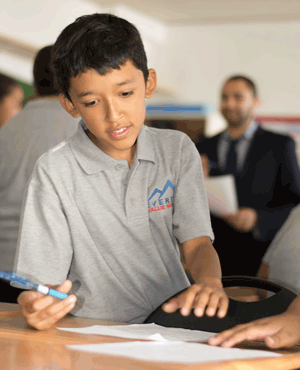Reading Level Assessments: All K-8 literacy teachers have been trained on how to assess students’ independent reading levels using the STAR Reading Test. This computer-based test assesses 46 reading skills in four major skill areas: foundational skills, reading literature, reading informational text, and language. The test also provides teachers with an instructional and independent reading level for each student. The data from this assessment is used by teachers to target and differentiate instruction and is communicated to students and parents to help each student select books at the appropriate level. All 1st-8th grade teachers are required to assess students’ reading levels at the beginning of the year and then re-administer the test every 8-12 weeks to measure growth.
Independent Reading: Based on research showing that time spent independently reading is the best predictor of reading achievement, Everest Value School places a strong emphasis on giving students adequate time for reading self-selected books at their independent reading level during the school day. All K-8 literacy teachers include 15-45 minutes of silent sustained reading in their schedule each day, with the amount of time increasing throughout the grade levels. Teachers also assign at least 20 minutes of independent reading for homework each night to give students more reading time each day. Students are held accountable for this by completing a reading log to keep track of the time they spend reading and by taking reading quizzes on Accelerated Reader.
Leveled Classroom Libraries: To support independent reading time, all classrooms have leveled libraries with quality texts at a broad range of reading levels. Libraries are organized to give students easy access to books at their independent reading level and each teacher trains their students on how to use the classroom library.
Targeted Literacy Instruction: Reading and writing are heavily emphasized in every classroom at Everest Value School. Lower elementary teachers use literacy centers, guided reading, read alouds, and a variety of phonics, fluency, and vocabulary activities to develop foundational reading skills needed for future success. Upper elementary and middle school teachers expose students to a variety of complex texts and teach close reading strategies to support students in thinking critically about what they read. All teachers differentiate literacy instruction to support each student in their areas of need using data from the NWEA benchmark and STAR Reading test.
Words Their Way: As part of the data driven model of literacy instruction, Everest K-2 cluster has adopted the Words Their Way program to support phonics instruction and progress monitoring. Three times a year, teachers will give the spelling inventory to all students to assess how to plan their RTI reading time. The inventory allows for readers to be grouped based on specific skill deficits from short vowels to blending and syllabic spelling. This data has correlated with the STAR test to guide teachers to provide an appropriate independent reading materials for students at these emerging stages.
Lucy Calkins: Everest purchased materials from the Lucy Calkins writing program after the academic council deemed that our slight declines in ELA scores on the SBAC were due to a lack of writing proficiency. These materials include writing rubrics, suggested pacing guides, exemplar writing samples, enrichment guides, and lesson scripts for teachers to follow. The materials have proven to be helpful for teachers and allow our students to improve in writing.
Voyages in English: Also in regards to our drop in ELA scores, Everest purchased a grammar program for Loyola Press to assist our students in their grammar study. Voyages has proven to be an easy and efficient manner in teaching grammar to our students. The worksheet clarify grammar objectives for our students and are quick lessons that don’t dominate class time.
Wordly Wise: The next addition to our literacy program this year is Wordly Wise vocabulary. The Wordly Wise lessons take vocabulary terms and have students learn the roots, suffixes, prefixes, and parts of speech in addition to word meanings. Students read the words within a short story, use them in sentences, and focus on their usage outside of the program so that students can engross themselves in the knowledge of new words.
Literacy Professional Development: Teachers are trained throughout the year on new strategies and best practices to improve literacy achievement. This has included professional development on implementing independent reading, setting up classroom libraries, using Accelerated Reader and STAR Reading, and strategies to help struggling readers.
School-wide Literacy Events: The mentor teachers wors with other teachers and staff members to plan events to encourage a love of reading in all students. These events include “reading marathons” throughout the school year, buddy reading between classes at different grade levels, teachers reading aloud to different grade levels to share their favorite books, and celebrating Read Across America Day.
